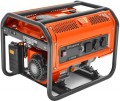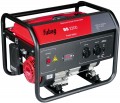Alternator winding
—
Copper. Copper winding is typical for advanced class generators. The copper alternator is characterized by high conductivity and low resistance. The conductivity of copper is 1.7 times higher than the conductivity of aluminium, such a winding heats up less, and compounds made of this metal endure temperature drops and vibration loads. Among the disadvantages of the copper winding, one can only note the high cost of the alternator. Otherwise, generators with copper winding have high reliability and durability.
— Aluminium. The aluminium winding of the alternator is typical for low-cost-class generators. The main advantages of aluminium are light weight and low price; otherwise, such a winding is usually inferior to copper counterparts. An oxide film is created on the surface of aluminium, it appears everywhere, even in the places of contact soldering. The oxide film undermines the contacts and does not allow the outer protective braid to securely hold the aluminium conductors.
Engine size
The working volume of the engine in a gasoline or diesel generator (see "Fuel"). Theoretically, more volume usually means more power, but in fact, everything is not so clear. Firstly, the specific power strongly depends on the type of fuel, and in gasoline units, also on the type of internal combustion engine (see above). Secondly, similar engines of the same power can have different volumes, and there is a practical point here: with the same power, a larger engine consumes more fuel, but by itself it can cost less.
Fuel consumption (50% load)
Fuel consumption of a petrol or diesel generator when operating at half power, and for combined models when using petrol (see “Fuel”).
Fuel consumption usually increases with load. However, generator efficiency is not always linear - fuel consumption may vary disproportionately with different loads. In this case, the approximate amount of fuel consumed by the generator when operating at half power (50% of the rated power) is given. Knowing the fuel consumption and tank capacity, you can at least estimate how long one fill-up will last.
Fuel tank volume
The volume of the fuel tank installed in the generator.
Knowing the fuel consumption (see above) and the capacity of the tank, you can calculate the operating time on one gas station (if it is not indicated in the specifications). However, a more capacious tank is also more bulky. Therefore, manufacturers choose tanks based on the general level and "voracity" of the generator — in order to provide an acceptable operating time without a significant increase in size and weight. So in general, this parameter is more of a reference than practically significant.
As for the numbers, in low-power models, tanks are installed for
5 – 10 liters, or even
less ; in heavy professional equipment, this figure can
exceed 50 liters.
Features
—
12V output. The presence of an output with direct power and voltage of 12 V in the generator. The main purpose of this output is to charge car batteries, as well as to power devices originally intended for cars (recall that 12 V is the standard voltage of on-board networks in passenger cars).
—
USB charging port . The presence of a USB connector (one or more) on the generator for charging various devices. Most modern smartphones and tablets can be charged via USB, and this charging method is also found in many other devices — from cameras and flashlights to electric screwdrivers and radio-controlled models. The standard supply voltage through this connector is 5 V, but the power may be different, it should be specified separately.
—
Smartphone control. Synchronization with a smartphone allows you to control the generator remotely. Thanks to this, the user does not need to approach the device to, for example, start or stop it. Additionally, synchronization with a smartphone allows you to monitor the parameters of the generated electric power remotely and in real time. On the other hand, this will require a constant connection to the Internet and specialized software that must be installed on the smartphone.
—
Autostart (ATS). A function that allows the generator to turn on automatically under certain conditio
...ns, without any action from the user. Autostart is mainly used when using the generator as a backup power source: while the main power is working, the unit is turned off, and if the voltage in the network disappears, ATS starts the engine, and power to the load begins to flow from the generator. Note that the presence of autostart is indicated only if the generator is initially equipped with an ATS electronic unit; models with the ability to connect such a unit are placed in a separate category (see below).
— ATS socket. A connector that allows you to connect an external autostart unit (ATS) to the generator; the unit itself is not included in the kit. For more information on autostart, see above; here we note that some users do not initially need this function, but may need it in the future — for example, if the generator is initially used for building a house, and then it is planned to be installed in the same house as a backup power source. In such situations, this configuration option will be optimal: when buying the generator itself, you will not have to overpay for the ATS unit, and later, if necessary, you can buy and connect such a unit separately.
— Automatic voltage regulator (AVR). An automatic regulator that allows maintaining a constant voltage level at the generator output. Such a regulator smooths out the differences that occur due to changes in the engine speed; this is especially important when connecting devices that are sensitive to power supply stability. It is worth noting that the presence of an AVR is almost mandatory for synchronous generators (see "Alternator"), but in other varieties this function is not found: in asynchronous and duplex units it is not applicable in principle, and in inverter units the role of the regulator is played by the inverter itself, and they do not require additional electronics.
— Display. A dedicated display mounted on the generator body. Typically, this is a simple LCD screen capable of displaying only numbers and some special symbols. However, even such a screen can display various useful information: voltage, frequency, engine hour meter data, low fuel warning, error code failure messages, etc. This makes control more convenient and visual.
— Hour metre. A device that counts the total time that the generator engine has been running since it was first turned on. This helps determine the overall wear of the engine and the need for repair/replacement, which can be useful both during long-term use of the device and, for example, to assess the quality of the product when buying a used generator. It is usually impossible to reset the hour meter without serious intervention in the design of the device.
— Voltmeter. A device that displays the power voltage produced by the generator. The voltmeter can be made in the form of a separate pointer scale, or its readings can be displayed on the generator's own display (see above). In any case, this function allows you to carefully monitor the unit's operating mode and reduces the risk that an unacceptable voltage will be applied to the load.
— Parallel connection. The presence of special connectors in the generator design, through which two or more units can be connected to a single electrical network (usually with the help of an additional device). This type of connection is used when one unit is not able to handle the entire load and the connection power exceeds the capabilities of the device itself. Also, such a scheme has gained popularity if one of the units is planned to be used as a backup power source.
— Remote start. The remote control generator is included in the delivery set. It is made in the form of a wireless key fob and allows you to turn on/off the device remotely without approaching it.Noise level
The noise level produced by the generator when operating in normal mode. The less noise the unit makes, the more comfortable it is to use, the closer it can be placed to people, but the higher its price, all other things being equal.
It is also worth considering that generators with internal combustion engines are, in principle, quite noisy equipment. Thus, even the "quietest" units produce
< 70 dB - this is the volume of a conversation in tones from medium to high. Accordingly, it is recommended to install the device remotely from the place of use. At the same time, we note that the noise level is not directly related to the power: for example, among units of 80 dB and more, there are both heavy and relatively low-power models.
Weight
The total weight of the unit - usually excluding fuel; the weight on full tank can be easily determined knowing the tank capacity.
In general, more powerful generators are inevitably heavier, but models with similar characteristics can differ significantly in weight. When assessing these differences and generally choosing an option based on weight, it is worth considering the specifics of the generator's use. So, if the device is often to be moved from place to place - for example, when used "on the road" - it may be worth paying attention to lighter units that are more convenient to transport. However, it is worth considering that the downside of a lightweight design is often an increased cost or a reduced degree of protection. But for stationary use, you can not pay special attention to this parameter - or even the opposite: choose a heavier (and, as a rule, more advanced and functional) option.
Regarding specific figures, it is worth noting that modern generators are generally quite massive. Thus, a small weight for such equipment is considered not only
< 20 kg, but even
20-30 kg ; many units weigh
150-200 kg, or even
more, and the weight of stationary industrial models is measured in tons.



